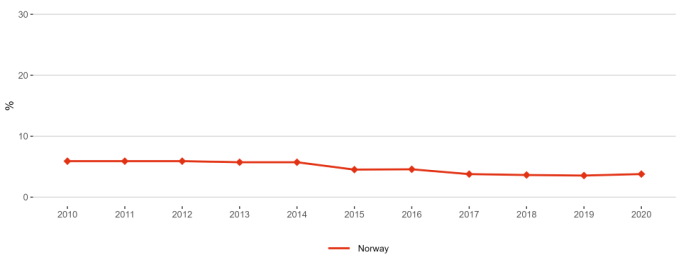ERA Country Report 2023
Norway
Edited by K. Haaland (UNU-MERIT)
as part of ‘Development of the ERA Scoreboard, the ERA Dashboard and the Regular Reports’ project for the European Commission, Directorate-General for Research and Innovation under Framework Contract N° 2018/RTD/A2/OP/PP-07001-2018 Lot 2 (EDAR)
Click here to download this country report![]()
- Table of contents
-
ERA Country Report 2023: Norway
1. National context
1.1. Overview of the ERA policy agenda implementation
1.2. Policy context
2. Assessment of the Implementation of the ERA Policy Agenda and ERA Priorities
2.1. ERA Priority 1: Deepening a truly functional internal market for knowledge
2.2. ERA Priority 2: Taking up together the challenges posed by the twin green and digital transition and increasing society’s participation in the ERA
2.3. ERA Priority 3: Amplifying access to research and innovation excellence across the Union
2.4. ERA Priority 4: Advancing concerted research and innovation investments and reforms
3. Country-specific drivers and barriers
4. Final remarks
5. Bibliography
6. Annexes
6.1. Annex 1: Graphs
ERA Country Report 2023: Norway
|
Key takeaways:
|
1. National context
1.1. Overview of the ERA policy agenda implementation
The EEA Agreement ensures Norway to associate to the EU Framework Programme and the European Research Area (ERA). From the Norwegian point of view, this is an opportunity for enterprises, research and public sector to gain and strengthen access to networks, infrastructure, capital and knowledge. ^ It is believed that cooperation with the EU will further strengthen the framework conditions for R&I in Norway. Looking at the country’s innovation track record, Norway is categorised as a Strong Innovator according to the European Innovation Scoreboard (EIS) 2023 with performance at 119.4% of the EU average.
Norway has committed to all of the 17 ERA actions of the ERA Policy Agenda 2022-2024. The Ministry of Education, in collaboration with relevant ministries, the Research Council of Norway, the University and College Council and others, has developed the National Action Plan for the European Research Area 2022-2024. It includes Norwegian measures for good follow-up and utilisation of the 17 ERA actions the country has committed to. It is a follow-up of to the Strategy for Norway’s participation in Horizon Europe and the European Research Area, which is crucial for strengthening Norwegian research and innovation in alignment with the ERA priorities. It is structured around four core objectives on research and innovation in the period 2021-2027 with the aim that participation shall increase quality of R&I, value creation, competitiveness, capacity to handle societal challenges as well as the development of new patterns of collaboration across national borders, sectors and fields. ^
1.2. Policy context
Research and innovation (R&I) policies are developed and implemented through a combination of national and regional institutions in Norway. Key actors at the national level are the Ministry of Education and Research (KD, Kunnskapsdepartementet), The Ministry of Trade, Industry and Fisheries (NFD, Nærings- og fiskeridepartementet), The Norwegian Research Council (RCN, Norges Forskningsråd) and Innovation Norway (Innovasjon Norge). While most R&I policies are developed and implemented at the national level, some decisions related to regional development and funding allocation may involve regional authorities such as the county councils.
Norway has established a national support system that plays an important role in supporting actors in their participation in Horizon Europe. Besides spreading information, increasing knowledge, identifying relevant applicants, and providing financial incentive schemes, the support system also advises the ministries. The Research Council and Innovation Norway are the main actors in the support system, but the Directorate for Higher Education and Skills, the Norwegian Space Agency, Enova and Investinor also play a role in some areas.
Important strategy documents include first and foremost the Long-Term Plan for Research and Higher Education (2022-2032). The overall objectives are linked to competitiveness and innovation capacity, environmental, social, and economic sustainability and high quality and accessibility in research and higher education. Several of the priorities align with ERA priorities, including open research and the value of data, academic freedom, and good Norwegian participation in EU knowledge initiatives for the green and digital transitions. A recurring point in the present long-term plan is that knowledge must be applied in society. The Long-Term Plan puts emphasis on participation in international research and education cooperation, not least related to societal challenges and crisis.
As a follow-up of an action point in the Long-Term Plan, a National Action Plan for the European Research Area 2022-2024 has been established. As introduced previously, the plan contains national actions to follow up on the ERA actions and complements the strategy for Norway’s participation in Horizon Europe and the ERA from 2021.
Additionally, other policy initiatives and measures that are relevant to the ERA priorities have been developed and implemented in the recent years. They include, but are not limited to, a National Strategy for Research Infrastructure (2019-2028), a National Strategy for Artificial Intelligence (AI) (2020), One digital public sector - Digital strategy for the public sector 2019–2025, the Research Council Policy for Open Science, and the Government’s Bioeconomy Strategy.
Besides from these specific plans, other government initiatives aligned with some of the ERA priority areas for joint action have been developed, notably in relation to the green transition and digital transformation. The initiatives include Norway’s Climate Strategy for 2030, the Green Industrial Initiative and the National Strategy for a Green, Circular economy.
2. Assessment of the Implementation of the ERA Policy Agenda and ERA Priorities
Chapter 2 has two objectives: 1) It qualitatively assesses the state-of-play of the implementation of the ERA actions that Norway has committed to. The information is based on information collected through desk research, with sources including national sources, information from the European Innovation Scoreboard, as well as the OECD STIP survey; 2) It quantitatively assesses the country’s progress towards achieving the ERA priorities as set out on the Pact for Research and Innovation in Europe.
|
Indicator |
Most Recent Metric |
|
Gross Domestic Expenditure on R&D (GERD) as a percentage of GDP |
1.94 (2021) |
|
Government Budget Allocations for R&D (GBARD) as a share of GDP |
0.913 (2021) |
|
Researchers (in full-time equivalent) per million inhabitants |
7,162.4 (2021) |
|
Business Enterprise expenditure on R&D (BERD) as a percentage of GDP |
1.0 (2021) |
Source: compiled by research team based on the ERA Scoreboard and ERA Dashboard indicators
The presented quantitative information is mainly based on the ERA Scoreboard and ERA Dashboard indicators and covers longer-term trends since 2010. Additionally, general indicators for the overall R&I system are outlined in Table 1. More detailed information on the data and graphs can be found in Annex 1. This report will serve as a baseline for reporting in the future.
2.1. ERA Priority 1: Deepening a truly functional internal market for knowledge
2.1.1. State of play in the implementation of the ERA Actions
Regarding ERA Action 1: Enable Open Science, including through the European Open Science Cloud (EOSC), the Long-Term Plan for Research and Higher Education puts emphasis on Open Science, information security and data infrastructure. The Norwegian Research Council works on key areas related to policy for Open Science, including participation, involvement and citizen science, reforming research assessment, making research data FAIR, data infrastructure and EOSC, open access to publications and Plan S, as well as responsible research and innovation. They have developed the national goals and guidelines for open access.
Norway has developed a national strategy for Artificial Intelligence, and the Norwegian Digitalisation Agency (Digdir) is a primary tool of the government for faster and more coordinated digitalisation of its public sector having developed guidance of ethical and trustworthy use of AI specifically in the public sector.
As regards ERA Action 2: Propose an EU copyright and data legislative framework for research Norway is committed to the international process of jointly developing the legislative framework. Several actors, such as the Norwegian Directorate for Higher Education and Skills (Direktoratet for høyere utdanning og kompetanse, HK-dr), Sikt and the National forum for Open Research, are involved in this action.
Concerning ERA Action 3: Reform the Assessment System for research, researchers and institutions, Norway has set up an Action Plan on Open Science since 2018 and is developing NOR-CAM (The Norwegian Career Assessment Matrix), which is a concrete toolbox for a broader and more flexible way to assess academic careers. The work is seen in conjunction with the COARA-process and the work done on revamping the national regulations for academic staff under the University and University Colleges Act. 20. Additionally, Universities Norway (UHR) have signed the Agreement on Reforming Research Assessment. ^
The implementation of ERA Action 4: Promote attractive research careers, talent circulation and mobility is seen in conjunction with different national strategies for recruiting researchers and career development, notably the Research's Strategy for the recruitment and career development of young researchers and the Research Council's new plan for recruitment to research and early careers. The former establishes foundations for early career researcher support, in alignment with career guidance frameworks and regulations like NOR-CAM. The latter follows up with Research Council activities covering national and international research funding, project-based initiatives, and capacity building programs, mainly targeting PhD-level individuals. Topics include entrepreneurship, fostering a culture of science, technology, innovation, and competitive research funding.
For ERA Action 5: Promote gender equality and foster inclusiveness, the Norwegian Research Council prioritises advancing gender balance in research and innovation globally and domestically. Starting from 2022, project proposals require a Gender Equality Plan at the organisational level. However, the business sector, special interest organisations and non-profit sector are exempt from the requirement. The new plan for recruitment to research and early career also covers aspects like equity, diversity, and inclusion. The government has developed an action plan focusing on female entrepreneurs. Additionally, specific initiatives, like Norway’s International Climate and Forest Initiative, focus on indigenous people. ^
The Committee for Gender Balance and Diversity in Research (KIF), appointed by the Ministry of Education and Research, has been working continuously to promote gender equality in higher education and research since 2004. The KIF Committee aims to increase knowledge about how gender, social and ethnic background affect critical transitions in research careers; from the path into research to senior-level and leadership positions. The KIF Committee supports and provides recommendations about measures that can help to improve the integration of the work for gender balance and diversity at universities, university colleges and research institutes. KIF has been working to mobilise the HEIs to meet the eligibility requirement on Gender Equality Plans (GEPs) in Horizon Europe. This has significantly increased the number of institutions with a GEP.
Commitment towards ERA Action 6: Protect academic freedom in Europe is evidenced by the appointment of the Expert Group for Academic Freedom of Expression by the Ministry of Education and Research on 20 July 2021. The ministry commissioned a study to this group to investigate possible threats to academic freedom of expression called Academic freedom of expression — A good culture of free speech must be built from the bottom up, every single day.
Regarding ERA Action 7: Upgrade EU guidance for a better knowledge valorisation, Norway is actively working on increasing value creation by bringing research results and ideas from publicly funded research institutions to the market. A recurring point in the present Long-term plan for Research and Higher Education is that knowledge must be applied in society. It stresses that knowledge must be made available and applied in business and industry as well as in the public sector and in civil society. There are a number of initiatives of relevance to the EU guidance for a better knowledge valorisation. One example is the FORNY scheme that facilitates the commercialisation of results from publicly funded research projects. In 2023, there has recently been a change in the FORNY programme to further strengthen the early commercialisation phase and to strengthen HEIs commercial exploitation.
The implementation of the ERA Action 8: Strengthen research infrastructures focusses on continued investment in existing and new national and international infrastructures, more targeted prioritisation, and the strategic analysis of the national research infrastructure landscape. This is done through the National Roadmap for Research Infrastructures (2023) and national Open Calls for funding. In addition, Norway participates in 19 ESFRI (ERIC) research infrastructures through the national nodes. The participation, development and upgrade of the national ESFRI nodes (and other international infrastructure types) is funded through the Research Council of Norway.
Moreover, NRIS (Norwegian research infrastructure services), in cooperation between Sigma2 and the four BOTT universities, delivers services within HPC (High Performance Computing) and storage of scientific data through a national e-infrastructure. Examples of other initiatives and international collaboration for ensuring access to HPC is the participation in the Large Unified Modern Infrastructure (LUMI) led by CSC’s data centre in Finland. Cooperation between research infrastructures, data infrastructures and stakeholders is strengthened through synergies with EOSC and the national participation in the partnership. It is worth mentioning that Norway is listed as EOSC Best Practice w.r.t. Big Data Infrastructure as well as Multidisciplinary Infrastructure.
Norwegian priorities in terms of ERA Action 9: Promote international cooperation are the EU multilateral dialogue on values and principles for international research ^ and the Team Europe initiative on China. Participation in the action complements and strengthens national efforts in the area of international cooperation, especially the Panorama strategy (2021-2027) and bilateral research and technology agreements and MoUs between Norway and the prioritised countries in this strategy. The Norwegian Panorama strategy defines the overarching principles and priorities for cooperation in higher education and research with prioritised countries outside of the EU. ^ The strategy introduced "responsibility" as a core principle for international cooperation, in line with established principles such as quality, relevance, reciprocity and long-term perspectives.
2.1.2. Progress towards achieving ERA Priorities
In relation to Sub-priority 1.1: Open science, the indicator related to share of open access scientific publications Norway scores 53.73% in 2019. In 2009 Norway scored 36.32%, thus there is a positive trend and a marked improvement (Figure 5 in Annex 1), where Norway has improved the position from being close to the average to being among the top 3 scoring countries. Norway is also listed as best practice in the EOSC Catalogue of Best Practice for FAIR Repository (DataverseNO), and Open Science Training. ^
With regards to progress related to Sub-priority 1.2: Research infrastructure, the share of national public R&D expenditure allocated to European research infrastructures in 2022 in Norway is of 0.95%. The data on the number of European research infrastructures in which Norway participates is not available.
Concerning progress related to Sub-priority 1.3: Gender equality, equal opportunities for all and inclusiveness, referring to Figure 6 in Annex 1, the share of females in grade A positions in HEIs has improved from a value of 22.9% in 2010 to 30.9% in 2018. Regarding the proportion (%) of females among doctoral graduates by narrow fields of Science, Technology and Mathematics (STEM), Norway scores 35.57% in 2013, and over time the proportion of females among doctoral graduates actually decreases to 32.79% in 2020 (Figure 8 in Annex 1). In terms of the indicator Proportion of females in authorship of the 10% most cited publications, in 2020 Norway scores 33.7% and it is relatively consistent over time (Figure 9 in Annex 1). For the proportion of papers with mixed gender authorship, there is an improvement for Norway from 47.8% in 2010 to 56.8% in 2020 (see Figure 7 in Annex 1).
Regarding the progress related to Sub-priority 1.4: Researchers’ careers and mobility and research assessment and reward systems, referring to Figure 10 in Annex 1, the share of foreign doctorate students as a percentage of all doctorate students remains relatively stable, and improves slightly from 20.6% in 2015 to 22.7% in 2020. Figure 11 in Annex 1 shows a decrease in new doctorate graduates per 1,000 inhabitants aged 25-34, from 1 in 2013 to 0.8 in 2020. Figure 12 in Annex 1 depicts the Job-to-job mobility of Human Resources in Science and Technology, and with minor variations remain relatively stable, starting out at 8.6 in 2010 and developing to 9.2 in 2020. As a final note, Norway is also recognised as EOSC Best Practice for Recognition and Rewards ^.
For Sub-priority 1.5: Knowledge valorisation, Figure 13 in Annex 1 shows the number of PCT patent applications divided by GDP in million Euros. For Norway this remains relatively stable, going from 0.002224 in 2010 to 0.001836 in 2015. Figure 14 in Annex 1 shows a relatively stable business enterprise research as % of national researchers, with initial value of 47.27% in 2010 having improved to 51.01% in 2020. The business enterprise researchers in FTE per thousand employees in industry shows a positive trend, improving from 7.70 in 2010 to 10.66 in 2020 (Figure 15 in Annex 1). Figure 16 in Annex 1 shows the share of innovating firms collaborating with higher education institutions or public/private research institutions (HEI/PRO) of all innovative firms, which for Norway has some yearly variation, going from 15.8 in 2010 to 14.33 in 2020.
With regard to Sub-priority 1.6: Scientific leadership, looking at the Academic Freedom Index (AFi), this has remained relatively stable at a high level of 0.923 in the period 2010-2020 (Figure 18 in Annex 1). The other indicator related to scientific leadership is the number of scientific publications among the top-10% most cited publications worldwide as a percentage of all publications. This value has also been quite consistent, with 12.4% in 2010 and with a slight decrease to 10.9% in 2020. (Figure 17 in Annex 1).
Regarding Sub-priority 1.7: Global engagement, turning to the indicator for international co-publications with non-EU partners per 1,000 researchers (in FTE) in the public sector, there has been a clear increase over time. In 2010 the number of these publications was 1,515.38, which more than doubled by 2022 with a number of 3,358.17 (Figure 19 in Annex 1). The other indicator of global engagement is related to European and international co-patenting in EPO applications at national and EU level. There is scarce data, but in 2010 the number of patents was 464, which decreased to 339 in 2013 (Figure 20 in Annex 1).
2.2. ERA Priority 2: Taking up together the challenges posed by the twin green and digital transition and increasing society’s participation in the ERA
2.2.1. State of play in the implementation of the ERA Actions
ERA Action 10: Make EU research and innovation missions and partnerships key contributors to the ERA. The Norwegian participation in EU missions was anchored at the highest level of government in December 2021. Work is also ongoing to launch national missions as defined in the Long-Term Plan in addition to participation in the EU missions.
Norway takes part in all but one of the co-funded partnerships launched in two waves in the first part of Horizon Europe. Synergies and complementarities with national R&I programs are emphasised. Norway also takes part in the Partnership Knowledge Hub and contributes to the monitoring of partnerships through this body.
For ERA Action 11: An ERA for green transformation the National strategy for research and innovation within new climate friendly energy technology (Energy21) is a core instrument towards the enhancement of this action. Focused on promoting coordinated efforts in the business sector, Energi21 strives to advance the development, demonstration, and commercialisation of climate-friendly energy technology for both stationary purposes and transportation. Additionally, Nysnø Climate Investment is the climate investment company of the Norwegian government, focusing on investing in enterprises that offer profitable and intelligent solutions to address the issues posed by climate change.
With regards to ERA Action 12: Accelerate the green/digital transition of Europe’s key industrial ecosystems, the national strategy for a green, circular economy, introduced in 2021, states that Norway will be an active participant in Europe's green transition and cooperate with the EU on framework conditions that promote circularity in both EU and Norway. Additionally, the Government's green industrial strategy defines 100 measures, evidencing how Norway will succeed with new, green industrial establishments and strengthen existing industry. In the strategy, the government points to seven focus areas with great growth opportunities: offshore wind, hydrogen, batteries, the maritime industry, CO2 management, forestry, wood and bioeconomy, and the process industry. Both the strategies emphasise physical and digital infrastructure, in general and connected to technology, including test facilities.
Regarding ERA Action 13: Empower Higher Education Institutions Norway already participates in most of the actions at European level which are strongly connected with Action 13, including Horizon Europe and Erasmus+ activities and the European Universities initiative. At national level, higher education institutions are expected to take advantage of the synergies between research, innovation and higher education, both at national level and when cooperating internationally, including in Horizon Europe and Erasmus+.
The Norwegian Centres of Excellence schemes (the SFF scheme) provides researchers with the opportunity to organise their research activities in centres that seek to achieve ambitious scientific objectives through collaboration.
In terms of ERA Action 14: Bring Science closer to citizens the Research Council Policy for Open Science incorporates concrete objectives on citizen science. The Research Council is establishing a national network for citizen science to enhance mutual learning and sharing of experiences across institutions and societal sectors, which has been recognised as Best Practice by EOSC. Additionally, the council also participates in the EU funded project PRO-Ethics, which is working with research and innovation funding organisations across Europe to test new, ethical ways to involve citizens in decision making processes.
There is also a range of prizes and awards in order to connect science closer to citizens, such as the awards of the research council of Norway, the Abel Prize, the Holberg prize and the Kavli prize. Various initiatives such as public awareness campaigns and other outreach activities are also organised, such as the National Science Week or Nysgjerrigper which target children and young people to learn about research and try to do research themselves.
2.2.2. Progress towards achieving ERA Priorities
For the Sub-priority 2.1: Challenge-based ERA actions an indicator refers to Government Budget Allocations for R&D (GBARD) by NABS in energy; environment; transport, and telecommunications and other infrastructure. In Figure 21 in Annex 1, it is apparent that GBARD for Transport, telecommunications & other infrastructure is consistently the lowest, with 55.97 in 2010 and with minor yearly variations ending at 56.764 in 2021. For Energy it is decreasing over time, starting out with 113.889 in 2010 and decreasing to 85.911 in 2021. The third category is GBARD for Environment, which over time has been increasing and surpassing the budget of energy and reaching the highest value of 105.282 in 2021.
Figure 22 shows the R&I investments (transnational cooperation: (GBARD)) allocated to Europe-wide transnational, bilateral or multilateral, public R&D programmes per FTE researcher in the public sector. With a starting value of 2,498.6 in 2010, the value has decreased to 2,075.1 in 2020. Moreover, Figure 23 in Annex 1 portrays the environmentally related government R&D budget as a percentage of total government R&D, which starts out at 2.63% in 2010 and remains relatively stable throughout the period, being at 2.70% in 2021. Finally, Figure 24 in Annex 1 shows the OECD Patents on environment technologies. For Norway the number of patents fluctuates a bit, starting with 13.99 in in 2010 and ending on 13.9 in 2020, however in the time period it is as low as 8.04 in 2014.
Towards Sub-priority 2.2: Synergies with education and the European Skills Agenda, the share of researchers receiving transferable skills training has decreased quite clearly from 2016 where it was 72% to only 50.9% in 2019 (Figure 25 in Annex 1).
Sub-priority 2.3: Synergies with sectorial policies and industrial policy, in order to boost innovation ecosystems is measured through direct government support and indirect government support through R&D tax incentives as a percentage of GDP (Figure 26 in Annex 1). This has been slowly increasing from 0.1304% in 2010 to 0.2352 in 2020. Norway started out at a low number but has doubled its value in the period.
In relation to Sub-priority 2.4: An active citizen and societal engagement in R&I in all its dimensions, trust in science indicator had the value of 46.93% in 2021. In Figure 27 in Annex 1 the development of research on social innovation (publications on “social innovation” or “social entrepreneurship”) per million population can be observed. Norway started out with a low rate of 0.411 in 2010, with a peak of 8.161 in 2020 and back down to 4.239 in 2021.
2.3. ERA Priority 3: Amplifying access to research and innovation excellence across the Union
2.3.1. State of play in the implementation of the ERA Actions
For ERA Action 16: Improve EU-wide access to excellence, the initiatives presented under action 17 below also contribute to the implementation of this action. Norway contributes more than EUR 200 million to research and capacity building in widening countries through the EEA and Norway Grant. In the previous funding period (2014-2021), the grants supported more than 300 research projects in widening countries, the majority of which also involve Norwegian research organisations. While this funding scheme is not formally connected with Horizon Europe or ERA, the programmes supported by the grants strive to align with Horizon Europe and ERA policies and practices, in order to provide a training ground and prepare for Horizon Europe and ERA participation.
Regarding ERA Action 17: Enhance public research institutions’ strategic capacity, the organisation mainly involved in the implementation is Universities Norway and their Norwegian Network for Administration and Research Management (NARMA). Throughout the years research institutions have been improving their strategic capacity by participating in EU Framework programmes, the European strategy forum on research infrastructure, and similar activities.
2.3.2. Progress towards achieving ERA Priorities
Sub-Priority 3.1: More investments and reforms in countries and regions with lower R&I performance is measured through the increase (in percentage points) of total R&D expenditure expressed as a percentage of GDP (Figure 29 in Annex 1). In 2010 it was a small decrease of 0.02%, and the decrease became larger by 2021 with a decrease of 0.31%.
2.4. ERA Priority 4: Advancing concerted research and innovation investments and reforms
2.4.1. State of play in the implementation of the ERA Actions
In the context of ERA Action 19: Establish an efficient and effective ERA monitoring mechanism the national statistical institute of Norway, Statistics Norway (Statistisk sentralbyrå, SSB), collects key data regarding R&I. ^ Additionally, in collaboration with NIFU and published by the Research Council, they developed the Indicator Report (Indikatorrapporten). It is an annual report on the Norwegian research and innovation system. Additionally, R&I in the area of health care is also monitored through HelseOmsorg21 monitor (HO21 monitor).
2.4.2. Progress towards achieving ERA Priorities
In relation to Sub-priority 4.1: Coordination of R&I investments, Figure 30 in Annex 1 shows the share of public R&D expenditures financed by the private sector. This remained relatively stable throughout the period, starting at 5.9% in 2010 and decreasing to 3.79% by 2020.
3. Country-specific drivers and barriers
Positive underpinnings for Norway’s progress in achieving the ERA priorities are:
-
the consistent high-level investments in R&D given the size of the economy, where both government and the private sector are making innovation a priority;
-
the willingness and eagerness to collaborate internationally, where Norway is facilitating research collaboration opportunities, establishing links and exchanging knowledge in order to foster R&I. The focus on the six strategic thematic areas in the current Norwegian R&I strategy includes oceans and coastal areas, health, climate, the environment and energy, enabling and industrial technologies, societal security and civil preparedness and trust and community.
The challenges Norway faces are mainly related to its participation in the EU Framework Programmes as an associated Country, in particular a lack of clarity concerning the legal basis for EEA/EFTA States’ participation. Moreover, Norwegian research priorities may not in all instances be aligned with EU priorities. In rare cases there are regulatory differences between Norway and the EU, although around three quarters of all EU-legislation is taken onboard through the EEA Agreement.
4. Final remarks
Norway has committed to all ERA Actions for the period 2022-2024. In terms of the ERA Policy Agenda, the country has registered a good performance in most aspects under ERA Priority 1, open science or research infrastructures among others. However, some challenges as the lack of incentives of the R&D system have led to a decrease in the number of new graduates, while other indicators as the academic freedom index have registered stagnation during the period. Similarly, most indicators of ERA Priority 2 have stayed around the same values in recent years. Still, the government support to R&D and the level of social innovation have increased consistently. In the case of ERA Priorities 3 and 4, the indicators have evidenced that further efforts are needed in those areas as they have gradually decreased.
In sum, Norway has demonstrated its commitment with the ERA Policy Agenda and has obtained good results in general R&I terms. Nevertheless, there exits room for improvement in some areas. To this end, Norway has established national initiatives to address the current challenges such as the Long-Term Plan for Research and Higher Education or the National Action Plan for the European Research Area 2022-2024.
5. Bibliography
Council of the European Union, 2021, Council Recommendation on a Pact for Research and Innovation in Europe https://data.consilium.europa.eu/doc/document/ST-13701-2021-INIT/en/pdf
Det Kongelige Kunnskapsdepartement Meld. St. 18 (2014–2015) Melding til Stortinget, Konsentrasjon for kvalitet Strukturreform i universitets- og høyskolesektoren https://www.regjeringen.no/no/dokumenter/meld.-st.-18-2014-2015/id2402377/
European Commission, 2023, European Innovation Scoreboard 2023 - Country profile Norway https://ec.europa.eu/assets/rtd/eis/2023/ec_rtd_eis-country-profile-no.pdf
Forskningsrådet, 2022, Forskningsrådets plan for rekruttering til forskning og tidlig karriere https://www.forskningsradet.no/siteassets/publikasjoner/2023/forskningsradets-plan-for-rekruttering-til-forskning-og-tidlig-karriere.pdf
Innovation Norway, 2023, https://en.innovasjonnorge.no/
Kunnskapsdepartementet, 2023, Nasjonal handlingsplan for Det europeiske forskningsområdet 2022–2024, https://www.regjeringen.no/contentassets/7903662193364452b11aaf27fcc96d88/no/pdfs/nasjonal-handlingsplan-for-europeiske-forskingsomr.pdf
Norwegian Ministries, 2016, Familiar resources – undreamt of possibilities, The Government’s Bioeconomy Strategy, https://www.regjeringen.no/contentassets/32160cf211df4d3c8f3ab794f885d5be/biookonomi-eng-kortversjon_uu.pdf
Norwegian Ministry of Climate and Environment, 2017, Norway’s Climate Strategy for 2030: a transformational approach within a European cooperation framework, Meld. St. 41 (2016 – 2017) Report to the Storting, https://www.regjeringen.no/en/dokumenter/meld.-st.-41-20162017/id2557401/
Norwegian Ministry of Education and Research, 2020, Norwegian comments to the European Commission's communication on the new European Research Area https://kifinfo.no/sites/default/files/norwegian_contribution_to_the_communication_on_a_new_era.pdf
Norwegian Ministry of Education and Research, 2021, Strategy for Norway’s participation in Horizon Europe and the European Research Area https://www.regjeringen.no/contentassets/68895f46b6f34f1a9294ca3be7d25265/214092-kd-strategi-horisonteuropa-web.pdf
Norwegian Ministry of Local Government and Modernisation, 2019, One digital public sector, Digital strategy for the public sector 2019–2025 https://www.regjeringen.no/contentassets/db9bf2bf10594ab88a470db40da0d10f/en-gb/pdfs/digital_strategy.pdf
Norwegian Ministry of Local Government and Modernisation, 2020, The National Strategy for Artificial Intelligence https://www.regjeringen.no/contentassets/1febbbb2c4fd4b7d92c67ddd353b6ae8/en-gb/pdfs/ki-strategi_en.pdf
Openscience.no n.d. https://www.openscience.no/en
Regjeringen.no Norge vil delta bredt i iverksettelsen av ERA-tiltak, 2022, https://www.regjeringen.no/no/aktuelt/norge-vil-delta-bredt-i-iverksettelsen-av-era-tiltak/id2937739/
Samfunnsøkonomisk analyse AS, 2019, Norwegian industry-related R&I policy agencies, measures and beneficiaries -A mapping conducted as a part of the study on “Raising the ambition- level in Norwegian research and innovation policy” https://www.forskningsradet.no/siteassets/publikasjoner/2019/samfunnsokonomisk-analyse---mapping.pdf
Technopolis, 2019, Raising the Ambition Level in Norwegian Innovation Policy https://www.forskningsradet.no/siteassets/publikasjoner/2019/technopolis-naringsrettede-virkemidler.pdf
The Norwegian Agency for Quality Assurance in Education (NOKUT), https://www.nokut.no/en/
The Research Council of Norway, n.d. Gender balance and gender perspectives https://www.forskningsradet.no/en/research-policy-strategy/gender-balan…
The Research Council of Norway, n.d. Portfolios, https://www.forskningsradet.no/en/portfolios/ , https://www.forskningsradet.no/en/Portfolios/education-and-competence/
The Research Council of Norway, 2018, Tools for Research National strategy for research infrastructure 2018–2025 National Financing Initiative for Research Infrastructure (INFRASTRUKTUR) https://www.forskningsradet.no/siteassets/publikasjoner/1254037350830.pdf
The Research Council of Norway, 2018, Norwegian Roadmap for Research Infrastructure 2018, National Financing Initiative for Research Infrastructure (INFRASTRUKTUR) https://www.forskningsradet.no/siteassets/publikasjoner/1254037351440.pdf
The Research Council of Norway, 2020, The Research Council Policy for Open Science, https://www.forskningsradet.no/siteassets/forskningspolitisk-radgivning/apen-forskning/nfr-policy-open-science-eng.pdf
The Research Council of Norway, 2020, Evaluation of the Norwegian Centres of Excellence (SFF) Funding Scheme https://www.forskningsradet.no/siteassets/publikasjoner/2020/sff_evaluation---main-report.pdf
The Research Council of Norway, 2022, Policy for Open Science, https://www.forskningsradet.no/en/research-policy-strategy/open-science/policy/
The Research Council of Norway, 2023, Open Science, https://www.forskningsradet.no/en/research-policy-strategy/open-science/
Universities Norway, 2022, Reforming academic career assessment in Norway: From cautious pioneer to avant-garde https://www.uhr.no/en/front-page-carousel/reforming-academic-career-assessment-in-norway-from-cautious-pioneer-to-avant-garde.6801.aspx
6. Annexes
6.1. Annex 1: Graphs
The 2023 ERA Scoreboard and ERA Dashboard indicators used in the country report are presented in this annex. Detailed information on the data sources, description of the indicators, time period for which the data is available, and the necessary calculations can be found in the ERA Scoreboard and ERA Dashboard Methodology Report. In addition, the research aimed to use the latest data available for each indicator, the most recent data for some of them dates from several years ago.
General Indicators

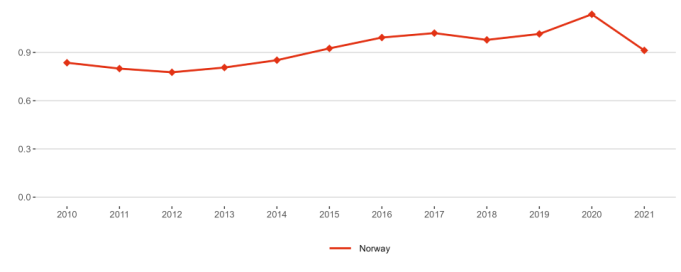
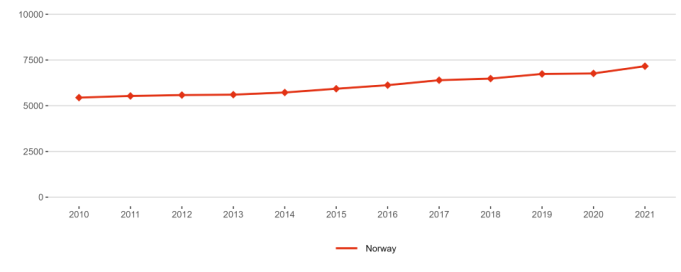
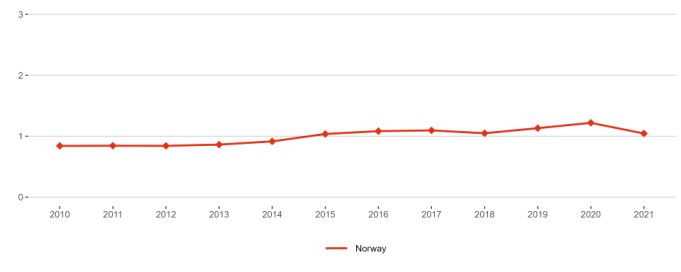
Priority 1: Deepening a truly functioning internal market for knowledge
Sub-priority 1.1: Open Science

Sub-priority 1.3: Gender equality, equal opportunities for all and inclusiveness
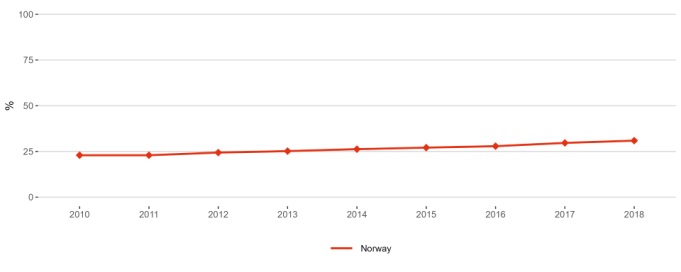


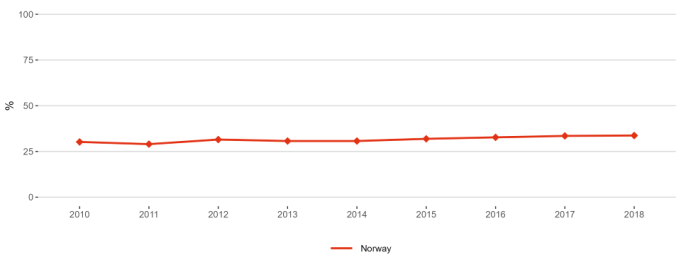
Sub-priority 1.4: Researchers’ careers and mobility and research assessment and reward systems


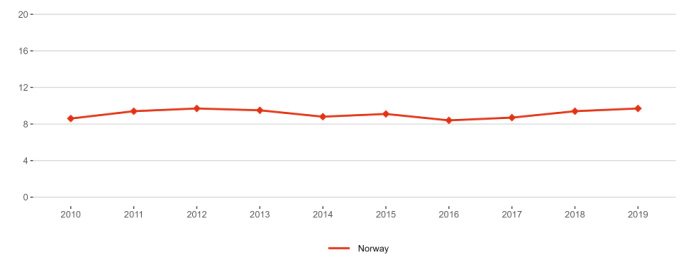
Sub-priority 1.5: Knowledge valorisation


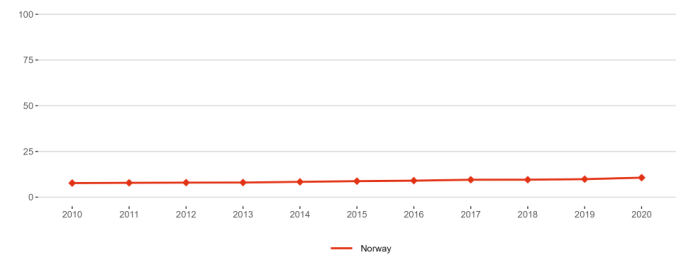

Sub-priority 1.6: Scientific leadership


Sub-priority 1.7: Global engagement
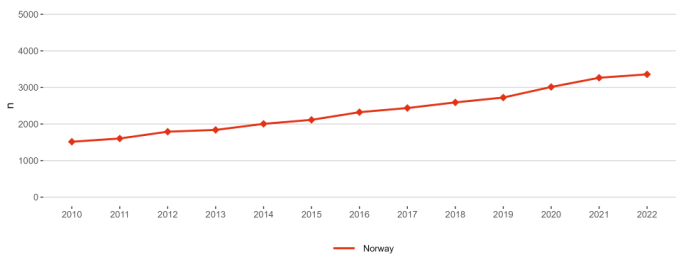
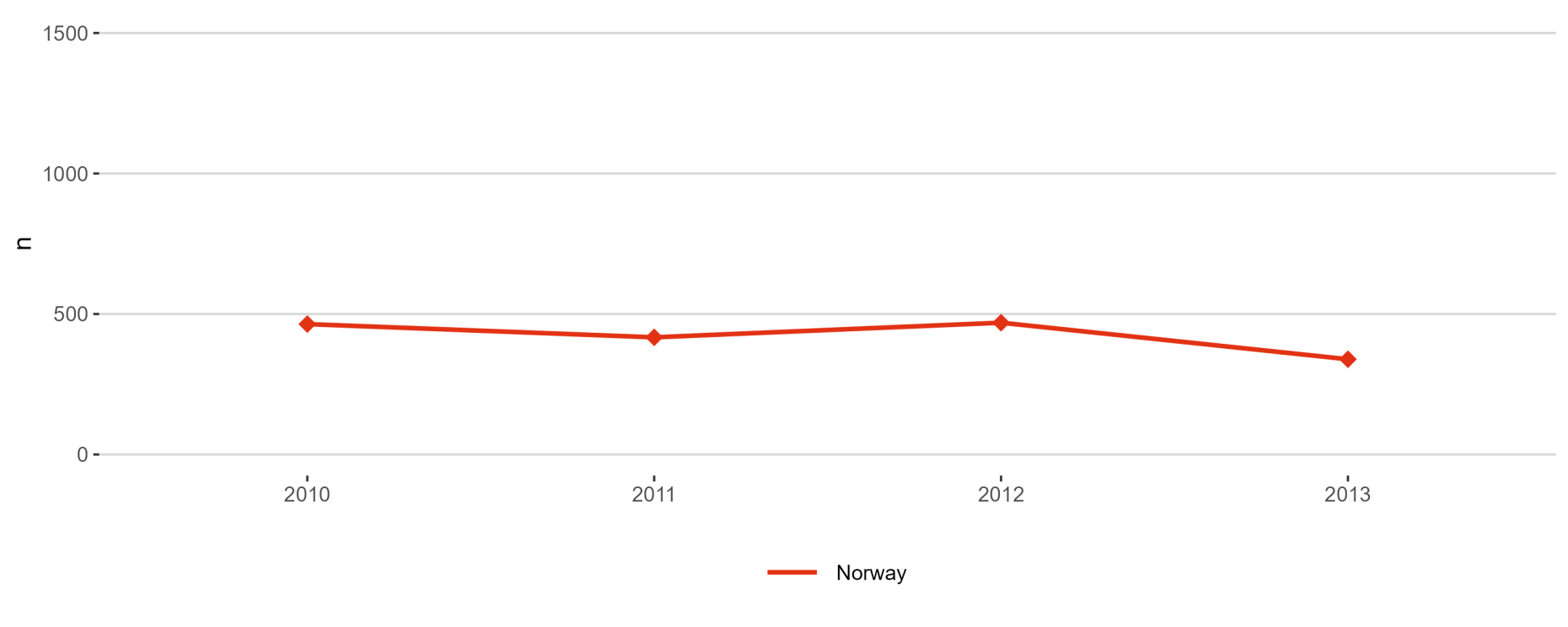
Priority 2: Taking up together the challenges posed by the twin green and digital transition, and increasing society’s participation in the ERA
Sub-priority 2.1: Challenge-based ERA actions
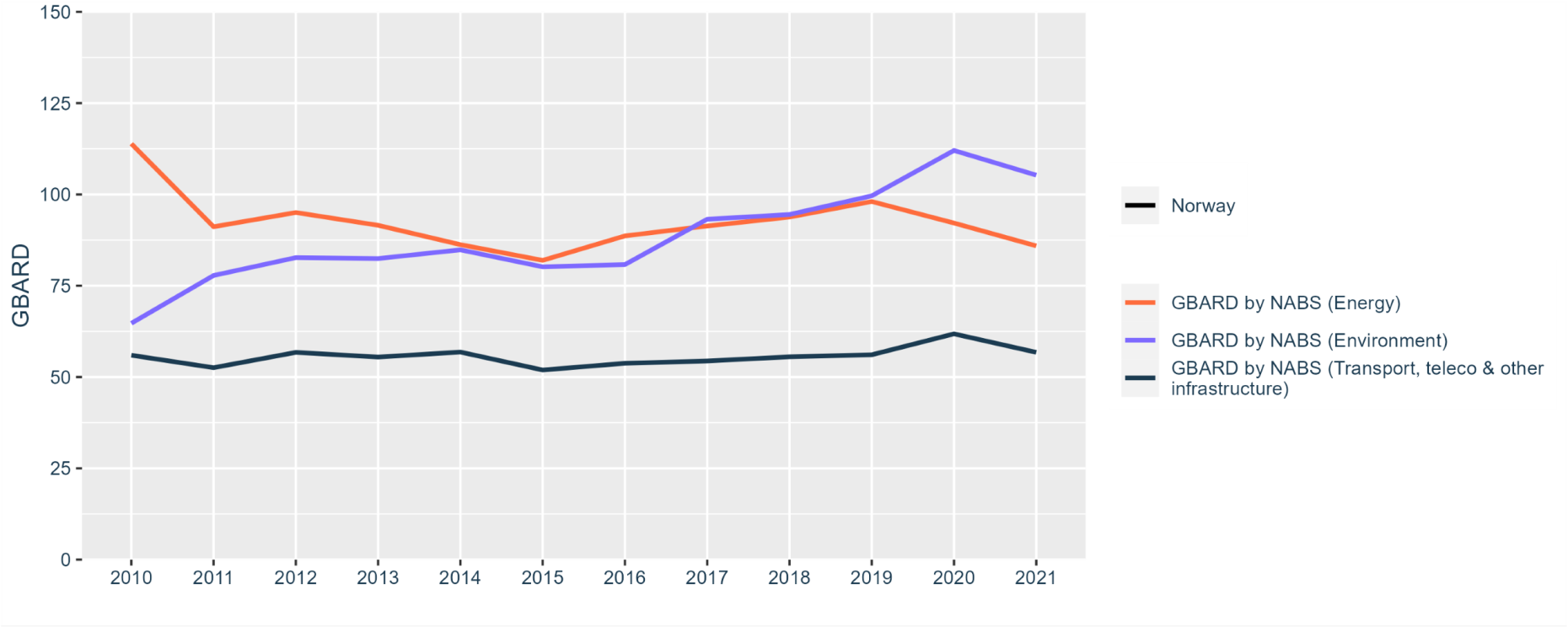
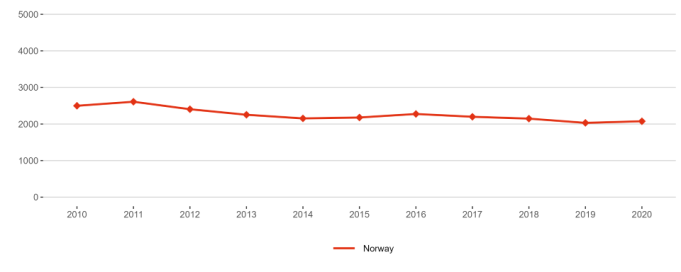

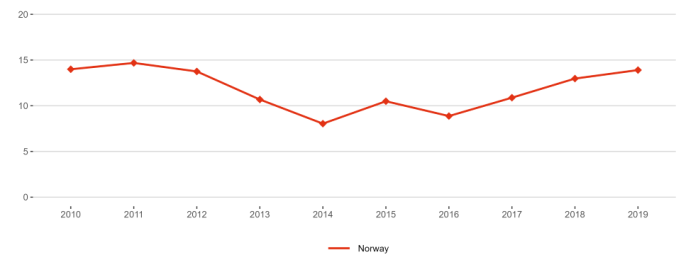
Sub-priority 2.2: Synergies with education and the European Skills Agenda

Sub-priority 2.3: Synergies with sectorial policies and industrial policy, in order to boost innovation ecosystems
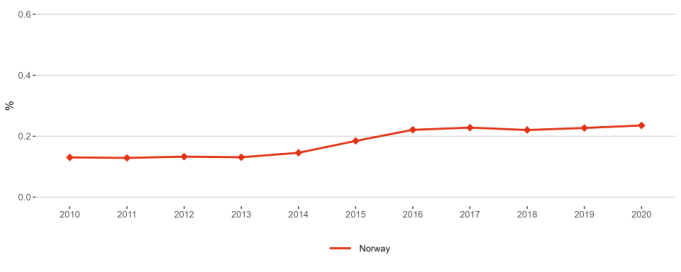
Sub-priority 2.4: An active citizen and societal engagement in R&I in all its dimensions

Priority 3: Amplifying access to research and innovation excellence across the Union
Sub-priority 3.1: More investments and reforms in countries and regions with lower R&I performance
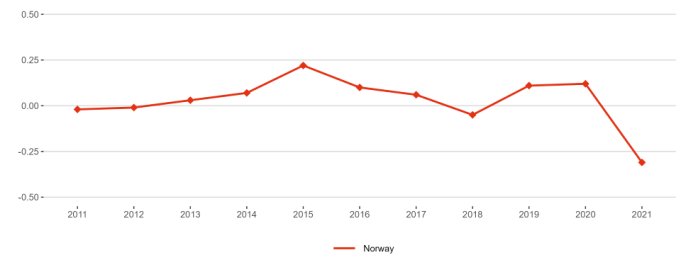
Priority 4: Advancing concerted research and innovation investments and reforms
Sub-priority 4.1: Coordination of R&I investments
